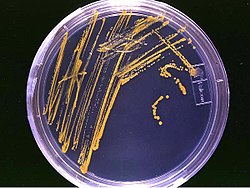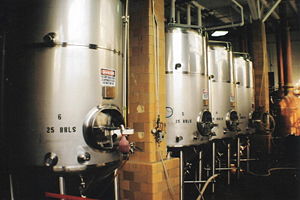Microbiology
Microbiology is the study of microorganisms, which are unicellular or cell-cluster microscopic organisms. This includes eukaryotes (with a nucleus) such as fungi and protists, and prokaryotes (without a nucleus) such as bacteria and viruses (though viruses are not strictly classed as living organisms).
Although much is now known in the field of microbiology, advances are being made regularly. The most common estimates suggest that we have studied only about 1% of all of the microbes in any given environment. Thus, despite the fact that over three hundred years have passed since the discovery of microbes, the field of microbiology is clearly in its infancy relative to other biological disciplines such as zoology, botany or even entomology.
History
Bacteria were first observed by Anton van Leeuwenhoek in 1676 using a single-lens microscope of his own design. The name "bacterium" was introduced much later, by Ehrenberg in 1828, derived from the Greek word βακτηριον meaning "small stick". While Antony van Leeuwenhoek is often cited as the first microbiologist, the first recorded microbiological observation, that of the fruiting bodies of molds, was made earlier in 1665 by Robert Hooke.
The field of bacteriology (later a subdiscipline of microbiology) is generally considered to have been founded by Ferdinand Cohn (1828-1898), a botanist whose studies on algae and photosynthetic bacteria led him to describe several bacteria including Bacillus and Beggiatoa. Ferdinand Cohn was also the first to formulate a scheme for the taxonomic classification of bacteria.
Louis Pasteur (1822-1895) and Robert Koch (1843-1910) were contemporaries of Cohn’s and are often considered to be the founders of medical microbiology. Pasteur is most famous for his series of experiments designed to disprove the then widely held theory of spontaneous generation, thereby solidifying microbiology’s identity as a biological science. Pasteur also designed methods for food preservation (pasteurization) and vaccines against several diseases such as anthrax, fowl cholera and rabies. Robert Koch is best known for his contributions to the germ theory of disease, proving that specific diseases were caused by specific pathogenic microorganisms. He developed a series of criteria that have become known as the Koch's postulates. Koch was one of the first scientists to focus on the isolation of bacteria in pure culture resulting in his description of several novel bacteria including Mycobacterium tuberculosis, the causative agent of tuberculosis.
While Louis Pasteur and Robert Koch are often considered the founders of microbiology, their work did not accurately reflect the true diversity of the microbial world because of their exclusive focus on microorganisms having medical relevance. It was not until the work of Martinus Beijerinck (1851-1931) and Sergei Winogradsky (1856-1953), the founders of general microbiology (an older term encompassing aspects of microbial physiology, diversity and ecology), that the true breadth of microbiology was revealed. Martinus Beijerinck made two major contributions to microbiology: the discovery of viruses and the development of enrichment culture techniques. While his work on the Tobacco Mosaic Virus established the basic principles of virology, it was his development of enrichment culturing that had the most immediate impact on microbiology by allowing for the cultivation of a wide range of microbes with wildly different physiologies. Sergei Winogradsky was the first to develop the concept of chemolithotrophy and to thereby reveal the essential role played by microorganisms in geochemical processes. He was responsible for the first isolation and description of both nitrifying and nitrogen-fixing bacteria.
Types of microbiology
The field of microbiology can be generally divided into several subdisciplines:
- Microbial physiology: The study of how the microbial cell functions biochemically. Includes the study of microbial growth, microbial metabolism and microbial cell structure.
- Microbial genetics: The study of how genes are organised and regulated in microbes in relation to their cellular functions. Closely related to the field of molecular biology.
- Medical microbiology: The study of the role of microbes in human illness. Includes the study of microbial pathogenesis and epidemiology and is related to the study of disease pathology and immunology.
- Veterinary microbiology: The study of the role in microbes in veterinary medicine.
- Environmental microbiology: The study of the function and diversity of microbes in their natural environments. Includes the study of microbial ecology, microbially-mediated nutrient cycling, geomicrobiology, microbial diversity and bioremediation. Characterisation of key bacterial habitats such as the rhizosphere and phyllosphere.
- Evolutionary microbiology: The study of the evolution of microbes. Includes the study of bacterial systematics and taxonomy.
- Industrial microbiology: The exploitation of microbes for use in industrial processes. Examples include industrial fermentation and wastewater treatment. Closely linked to the biotechnology industry. This field also includes brewing, an important application of microbiology.
- Aeromicrobiology: The study of Airborne Microorganisms.
- Food Microbiology: The study of Microorganisms causing Food Spoilage.
Benefits of microbiology
While microbes are often viewed negatively due to their association with many human illnesses, microbes are also responsible for many beneficial processes such as industrial fermentation (e.g. the production of alcohol and dairy products), antibiotic production and as vehicles for cloning in higher organsisms such as plants. Scientists have also exploited their knowledge of microbes to produce biotechnologically important enzymes such as Taq polymerase, reporter genes for use in other genetic systems and novel molecular biology techniques such as the yeast two-hybrid system.
References
- Madigan, Michael; Martinko, John (editors) (2005). Brock Biology of Microorganisms, 11th ed.. Prentice Hall. ISBN 0-13-144329-1.
- Ryan KJ; Ray CG (editors) (2004). Sherris Medical Microbiology, 4th ed.. McGraw Hill. ISBN 0-8385-8529-9.
- Schaechter, Moselio; Ingraham, John L.; Neidhardt (2006). Microbe, 1st ed.. ASM Press. ISBN 1-55581-320-8.
See also
External links
- GIDEON Microbiology tutorial
- Online Microbiology textbook
- Nature Reviews Microbiology (journal home)
- Bacteriology textbook
- Microbiology News
- American Society for Microbiology
- Society for General Microbiology
- Microbiology Animations (Flash)
af:Mikrobiologie an:Microbiolochía bg:Микробиология ca:Microbiologia cs:Mikrobiologie da:Mikrobiologi de:Mikrobiologie es:Microbiología eo:Mikrobiologio eu:Mikrobiologia fr:Microbiologie ko:미생물학 ilo:Microbiolohia id:Mikrobiologi it:Microbiologia he:מיקרוביולוגיה la:Microbiologia lv:Mikrobioloģija mk:Микробиологија nl:Microbiologie ja:微生物学 no:Mikrobiologi pl:Mikrobiologia pt:Microbiologia ro:Microbiologie ru:Микробиология sr:Микробиологија fi:Mikrobiologia tl:Mikrobiyolohiya th:จุลชีววิทยา vi:Vi sinh vật học tr:Mikrobiyoloji uk:Мікробіологія zh:微生物学

